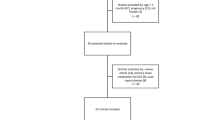Abstract
Dexmedetomidine (DEX), a central alpha-2-agonist, is being increasingly used in outpatient procedural sedation. Recent concerns about the time-honored hypnotic chloral hydrate’s carcinogenicity, genotoxicity, and more importantly lack of availability in the US market have led to DEX as a viable alternative to chloral hydrate in procedural sedation both as an intravenous (IV) medication and an intranasal medication.
Access this chapter
Tax calculation will be finalised at checkout
Purchases are for personal use only
Similar content being viewed by others
References
Zhang H, Yan X, Wang DG, et al. Dexmedetomidine relieves formaldehyde-induced pain in rats through both alpha2 adrenoceptor and imidazoline receptor. Biomed Pharmacother. 2017;90:914–20. https://doi.org/10.1016/j.biopha.2017.04.047.
Bloor BC, Ward DS, Belleville JP, Maze M. Effects of intravenous dexmedetomidine in humans. II. Hemodynamic changes. Anesthesiology. 1992;77(6):1134–42. https://doi.org/10.1097/00000542-199212000-00014.
Belleville JP, Ward DS, Bloor BC, Maze M. Effects of intravenous dexmedetomidine in humans. I. Sedation, ventilation, and metabolic rate. Anesthesiology. 1992;77(6):1125–33. https://doi.org/10.1097/00000542-199212000-00013.
Blaine Easley R, Brady KM, Tobias JD. Dexmedetomidine for the treatment of postanesthesia shivering in children. Paediatr Anaesth. 2007;17(4):341–6. https://doi.org/10.1111/j.1460-9592.2006.02100.x.
Mahmoud M, Radhakrishman R, Gunter J, et al. Effect of increasing depth of dexmedetomidine anesthesia on upper airway morphology in children. Paediatr Anaesth. 2010;20(6):506–15. https://doi.org/10.1111/j.1460-9592.2010.03311.x.
Lodenius A, Maddison KJ, Lawther BK, et al. Upper airway collapsibility during dexmedetomidine and propofol sedation in healthy volunteers: a nonblinded randomized crossover study. Anesthesiology. 2019;131(5):962–73. https://doi.org/10.1097/ALN.0000000000002883.
Perez-Zoghbi JF, Zhu W, Grafe MR, Brambrink AM. Dexmedetomidine-mediated neuroprotection against sevoflurane-induced neurotoxicity extends to several brain regions in neonatal rats. Br J Anaesth. 2017;119(3):506–16. https://doi.org/10.1093/bja/aex222.
Sato M, Shirakami G, Tazuke-Nishimura M, Matsuura S, Tanimoto K, Fukuda K. Effect of single-dose dexmedetomidine on emergence agitation and recovery profiles after sevoflurane anesthesia in pediatric ambulatory surgery. J Anesth. 2010;24(5):675–82. https://doi.org/10.1007/s00540-010-0976-4.
Petroz GC, Sikich N, James M, et al. A phase I, two-center study of the pharmacokinetics and pharmacodynamics of dexmedetomidine in children. Anesthesiology. 2006;105(6):1098–110. https://doi.org/10.1097/00000542-200612000-00009.
Anttila M, Penttila J, Helminen A, Vuorilehto L, Scheinin H. Bioavailability of dexmedetomidine after extravascular doses in healthy subjects. Br J Clin Pharmacol. 2003;56(6):691–3. https://doi.org/10.1046/j.1365-2125.2003.01944.x.
Bhana N, Goa KL, McClellan KJ. Dexmedetomidine. Drugs. 2000;59(2):263–8. https://doi.org/10.2165/00003495-200059020-00012; discussion 269–270.
Mahmoud M, Mason KP. Dexmedetomidine: review, update, and future considerations of paediatric perioperative and periprocedural applications and limitations. Br J Anaesth. 2015;115(2):171–82. https://doi.org/10.1093/bja/aev226.
Mason KP, Zurakowski D, Zgleszewski S, Prescilla R, Fontaine PJ, Dinardo JA. Incidence and predictors of hypertension during high-dose dexmedetomidine sedation for pediatric MRI. Paediatr Anaesth. 2010;20(6):516–23. https://doi.org/10.1111/j.1460-9592.2010.03299.x.
Sulton C, McCracken C, Simon HK, et al. Pediatric procedural sedation using dexmedetomidine: a report from the Pediatric Sedation Research Consortium. Hosp Pediatr. 2016;6(9):536–44. https://doi.org/10.1542/hpeds.2015-0280.
Mason KP, Zgleszewski S, Forman RE, Stark C, DiNardo JA. An exaggerated hypertensive response to glycopyrrolate therapy for bradycardia associated with high-dose dexmedetomidine. Anesth Analg. 2009;108(3):906–8. https://doi.org/10.1213/ane.0b013e3181948a6f.
Mason KP, O’Mahony E, Zurakowski D, Libenson MH. Effects of dexmedetomidine sedation on the EEG in children. Paediatr Anaesth. 2009;19(12):1175–83. https://doi.org/10.1111/j.1460-9592.2009.03160.x.
Lubisch N, Roskos R, Berkenbosch JW. Dexmedetomidine for procedural sedation in children with autism and other behavior disorders. Pediatr Neurol. 2009;41(2):88–94. https://doi.org/10.1016/j.pediatrneurol.2009.02.006.
Kamat PP, McCracken CE, Gillespie SE, et al. Pediatric critical care physician-administered procedural sedation using propofol: a report from the Pediatric Sedation Research Consortium Database. Pediatr Crit Care Med. 2015;16(1):11–20. https://doi.org/10.1097/PCC.0000000000000273.
Berkenbosch JW, Wankum PC, Tobias JD. Prospective evaluation of dexmedetomidine for noninvasive procedural sedation in children. Pediatr Crit Care Med. 2005;6(4):435–9. https://doi.org/10.1097/01.PCC.0000163680.50087.93; quiz 440.
Mason KP, Robinson F, Fontaine P, Prescilla R. Dexmedetomidine offers an option for safe and effective sedation for nuclear medicine imaging in children. Radiology. 2013;267(3):911–7. https://doi.org/10.1148/radiol.13121232.
Mason KP. Sedation trends in the 21st century: the transition to dexmedetomidine for radiological imaging studies. Paediatr Anaesth. 2010;20(3):265–72. https://doi.org/10.1111/j.1460-9592.2009.03224.x.
Tobias JD. Dexmedetomidine and ketamine: an effective alternative for procedural sedation? Pediatr Crit Care Med. 2012;13(4):423–7. https://doi.org/10.1097/PCC.0b013e318238b81c.
Mason KP, Zurakowski D, Zgleszewski SE, et al. High dose dexmedetomidine as the sole sedative for pediatric MRI. Paediatr Anaesth. 2008;18(5):403–11. https://doi.org/10.1111/j.1460-9592.2008.02468.x.
Mason KP, Lubisch NB, Robinson F, Roskos R. Intramuscular dexmedetomidine sedation for pediatric MRI and CT. AJR Am J Roentgenol. 2011;197(3):720–5. https://doi.org/10.2214/AJR.10.6134.
Cozzi G, Norbedo S, Barbi E. Intranasal dexmedetomidine for procedural sedation in children, a suitable alternative to chloral hydrate. Paediatr Drugs. 2017;19(2):107–11. https://doi.org/10.1007/s40272-017-0217-5.
Sulton C, Kamat P, Mallory M, Reynolds J. The use of intranasal dexmedetomidine and midazolam for sedated magnetic resonance imaging in children: a report from the Pediatric Sedation Research Consortium. Pediatr Emerg Care. 2017. https://doi.org/10.1097/PEC.0000000000001199.
Lewis J, Bailey CR. Intranasal dexmedetomidine for sedation in children; a review. J Perioper Pract. 2019:1750458919854885. https://doi.org/10.1177/1750458919854885.
Jun JH, Kim KN, Kim JY, Song SM. The effects of intranasal dexmedetomidine premedication in children: a systematic review and meta-analysis. Can J Anaesth. 2017;64(9):947–61. https://doi.org/10.1007/s12630-017-0917-x.
Mondardini MC, Amigoni A, Cortellazzi P, et al. Intranasal dexmedetomidine in pediatrics: update of current knowledge. Minerva Anestesiol. 2019. https://doi.org/10.23736/S0375-9393.19.13820-5.
Olgun G, Ali MH. Use of intranasal dexmedetomidine as a solo sedative for MRI of infants. Hosp Pediatr. 2018. https://doi.org/10.1542/hpeds.2017-0120.
Boriosi JP, Eickhoff JC, Klein KB, Hollman GA. A retrospective comparison of propofol alone to propofol in combination with dexmedetomidine for pediatric 3T MRI sedation. Paediatr Anaesth. 2017;27(1):52–9. https://doi.org/10.1111/pan.13041.
Barton KP, Munoz R, Morell VO, Chrysostomou C. Dexmedetomidine as the primary sedative during invasive procedures in infants and toddlers with congenital heart disease. Pediatr Crit Care Med. 2008;9(6):612–5. https://doi.org/10.1097/PCC.0b013e31818d320d.
Mohite V, Baliga S, Thosar N, Rathi N. Role of dexmedetomidine in pediatric dental sedation. J Dent Anesth Pain Med. 2019;19(2):83–90. https://doi.org/10.17245/jdapm.2019.19.2.83.
Sago T, Shiiba S, Ando E, et al. Sedation with a combination of dexmedetomidine and midazolam for pediatric dental surgery. Anesth Prog. 2018;65(2):124–6. https://doi.org/10.2344/anpr-65-03-14.
Muller S, Borowics SM, Fortis EA, et al. Clinical efficacy of dexmedetomidine alone is less than propofol for conscious sedation during ERCP. Gastrointest Endosc. 2008;67(4):651–9. https://doi.org/10.1016/j.gie.2007.09.041.
Author information
Authors and Affiliations
Corresponding author
Editor information
Editors and Affiliations
Rights and permissions
Copyright information
© 2021 Springer Nature Switzerland AG
About this chapter
Cite this chapter
Kamat, P.P. (2021). Alpha-agonists in Pediatric Procedural Sedation. In: Kamat, P.P., Berkenbosch, J.W. (eds) Sedation and Analgesia for the Pediatric Intensivist. Springer, Cham. https://doi.org/10.1007/978-3-030-52555-2_29
Download citation
DOI: https://doi.org/10.1007/978-3-030-52555-2_29
Published:
Publisher Name: Springer, Cham
Print ISBN: 978-3-030-52554-5
Online ISBN: 978-3-030-52555-2
eBook Packages: MedicineMedicine (R0)




